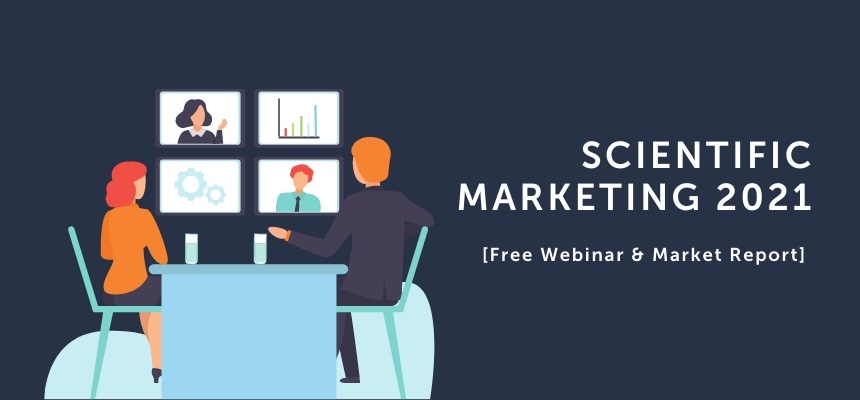
Download the market report: The State of Scientific Marketing 2021
The first webinar in our six-event marketing science series analysed the current state of scientific marketing in 2021.
Elizabeth, Franky, and Danny, the marketing team from AZo Network, shared their insights and key industry findings. This blog post includes some of those key points as well as links to the full market report and the on-demand webinar.
Who took the survey?
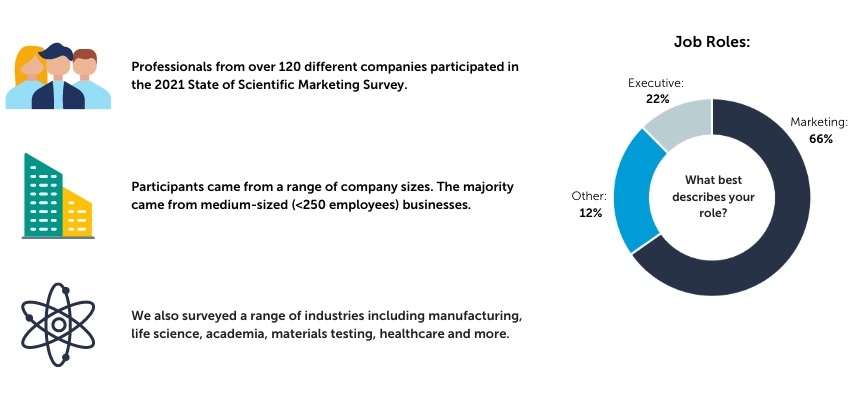
Contents
Watch the full on-demand webinar below.
Marketing Trends: MarTech, Social Media, and Virtual Events
MarTech
(Franky): CRM was the most widely used marketing technology, but perhaps more noticeable was the trend in marketers increasingly utilising the different marketing technologies available.
In the last 8 years, there's 8000 different software and technologies that allow you to do your job as a marketer better.
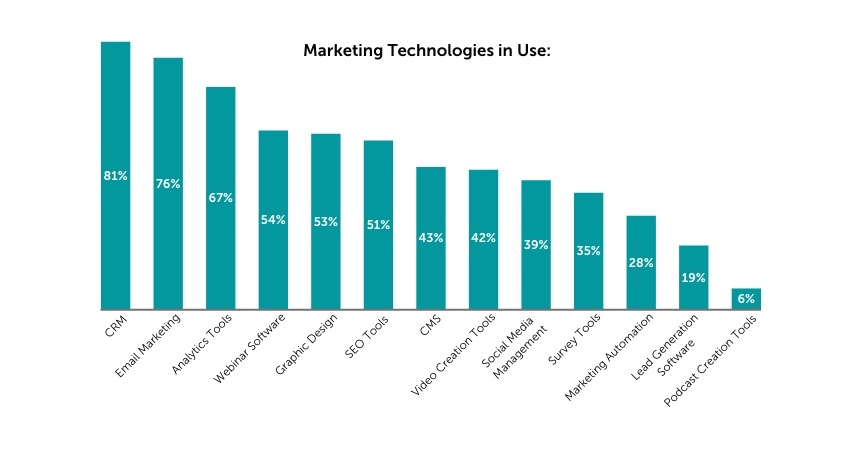
Looking at the 12 broad categories that we've got here, it's impossible to know everything across all of those.
If you are a generalist marketer then you will understand how things work and fit together but if you want more information about SEO tools, you'll likely go to an SEO specialist who will be able to walk you through Google Keyword Planner, or tools like SEMrush.
Similarly for webinars, we'd go to the team at InsideScientific, where we get a more in-depth knowledge into the ins and outs of our webinar platforms.

It's a similar story with our CRM. We use a specialist Salesforce consultant, which we go to if we've got specific technical or architectural issues that we need to solve.
There's loads of functionality that you can do with CRMs that many marketers are unaware of.
You can customize your CRM so that you can have your workflow and your operations in there. Do a little research and you'll find solutions to use it more effectively.
Whether you're using Salesforce, Microsoft, HubSpot, all these platforms are all competing with each other on a global scale to help companies grow.
If you don't own a CRM right now then we strongly recommend getting to grips with one. If you do own a CRM then explore how the other features can help solve problems that you face on a day-to-day basis.
More specifically for the marketing side of things, we're seeing a huge uptake in webinars, video creation, and visual content that's going to engage people.
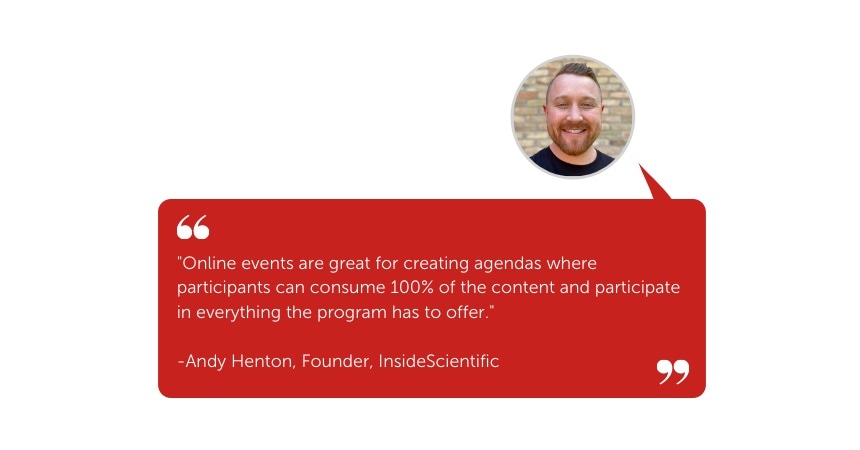
The third tip is investing in SEO tools. Marketers can see big increases in the number of relevant website visitors by getting their SEO strategy in order.
Digital Marketing for a Steel Company: Masteel Case Study
Social Media
(Danny): Unsurprisingly, LinkedIn is being used by a large number of our survey respondents (91%) to promote their businesses.
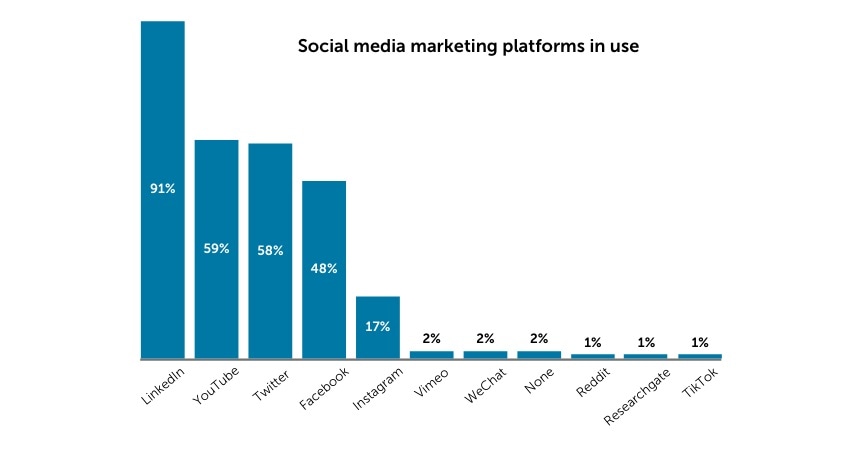
These large audiences provide some really interesting opportunities. B2B social media marketing is first and foremost, about branding and how your organization is perceived in the digital world.
You can use LinkedIn effectively in several ways, such as to:
- Build relationships
- Gain trust in yourself and the businesses you represent
- Grow your network
- Offer your expertise
- Learn from others
Now, these things are all much easier to achieve on LinkedIn if you're using your personal profiles, as opposed to your business pages.
The combined networks of your directors, sales and marketing teams are likely going to be larger than your business page and really relevant to what it is that you're trying to achieve as a business.
Think of ways to incentivize your wider teams to use LinkedIn more effectively and to make the most of their individual online network. This will help them to grow their personal brands and enhance the organization's online presence.
By setting goals such as:
- Connecting with X amount of people within a certain industry each week
- Ensuring that we're allocating 15 minutes a day to engage with our networks or to offer expertise where appropriate
It's a long-term strategy but you are going to see better results by using these goals with the intention of building your networks and increasing your engagement levels rather than thinking of LinkedIn as an immediate lead generation channel.

That stat above shows us a 21% increase in overall social media use which got us thinking about our paid social strategy.
Audiences are growing all the time and with that is the increase in opportunity for marketers. Most people are using social media to kill some time or be entertained, NOT be sold to. So your strategy, content and placement of your ads should reflects that.
We find that they're most effective in B2B for top of the funnel content that showcases your brand in a positive light and begins to start the conversations as opposed to simply advertising your latest products.
And it's not just about LinkedIn.
We've been running Facebook and Instagram campaigns to promote the Marketing Science Podcast, which we started last year. We've identified the potential listeners are more likely to be looking for a new podcast during their commutes, or in their free time as opposed to during the working days.
So we're aiming to connect with people within the business, not the business itself and our strategy reflects that.
In B2B, there's always a big focus on LinkedIn and rightly so but the other channels aren't to be forgotten and it's worth remembering that's Facebook, Instagram, Twitter, these can all be effective networks in which to find your target audience.

The final tip is about video marketing in the science industry. 59% of respondents were using YouTube, which is great. YouTube and video in general are amazing for communicating complexity in a more visual way.
41% of respondents aren't using video. So there lies a great opportunity if you're one of those organizations. The great thing about video is that it's really easily repurposed. You can publish it to your site, use snippets for other social media channels, include it in relevant blog posts. All ways to get the most from your investment.
Ask about video marketing
Virtual Events
(Elizabeth): We couldn't run this survey without talking a little bit about virtual events and trade shows. 62% of our survey respondents attended a virtual trade show in 2020 and of those people who did attend a virtual trade show, 85% found them less effective than face-to-face events.
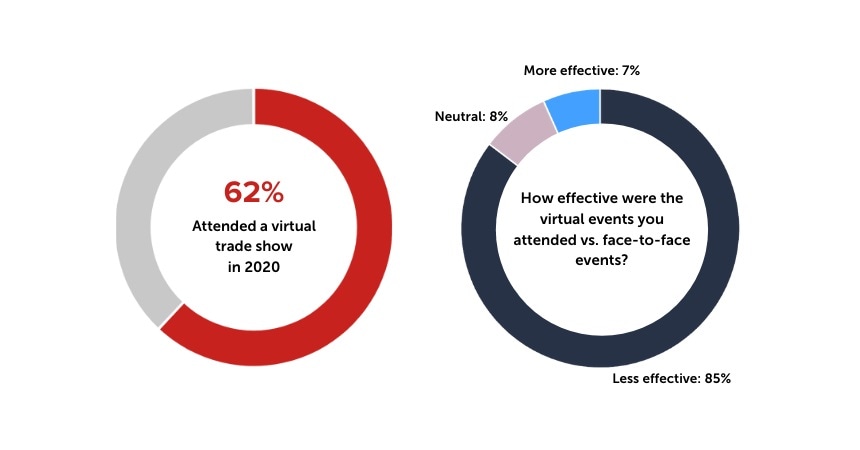
It's a little bit disappointing to see, but at the same time a lot of event providers have had to pivot very quickly and didn't have a ton of time to maybe establish best practices for virtual events.
The lack of time meant marketers and event planners were unable to explore some of the features that the platforms are developing now. There is a great opportunity, as we move into 2021 and beyond to establish some of those best practices and really find out what works well for a virtual event format.
On Demand Webinar: Using Content to Leverage Virtual Events
A virtual event is never going to exactly replicate a face-to-face event.
48% are still likely to attend some form of virtual event in 2021, so this is the time for marketers to work on their virtual event strategy.
That brings me on nicely to some tips for virtual event hosts and for exhibitors and attendees moving into 2021.
Marketing Science Podcast - Season 2 Episode 6: How to host a scientific virtual conference
AI facilitated matchmaking, which is similar to online dating. You fill out a profile with your interests, your area of expertise, whether or not you're looking to purchase or sell a solution or a product. The meetings are typically 10-15 minutes long so even in a shorter, half day event, you could really network with quite a lot of people.
Something else that's been sort of characteristic of successful event providers is their consideration of the mix of on-demand and live content. The ability to use this on demand content is great in terms of being able to avoid scheduling conflicts.
With some of the bigger trade show events, you definitely have multiple sessions, multiple presenters going on all at once. The fact that you can now attend one live and watch another one on demand is great.
A lot of the live content still have the live Q&As which offer ways to engage and connect during live sessions, but again, everything's often recorded. If you have a packed schedule or you're tuning in from a different time zone then you can watch in your own time and at your own leisure.
On demand content is often also being made available for three to four months after the event, which allows for more flexible and longer engagement with the content.
Don't be scared to try out some new ideas and have an open mind because virtual events are new for a lot of people.
Sales and the Customer Journey
(Franky): 17% of scientific marketers are passing fewer than one in 10 leads through as SQLs. They are more or less in the right ballpark. I'd say 83% of marketers are passing through far too many leads as SQLs.
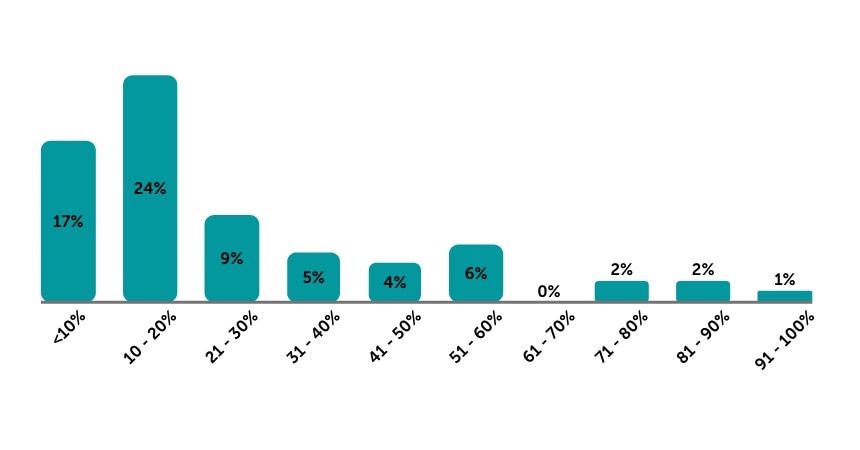
30% weren't sure about what numbers they were passing through so I think it's fair to assume that they're probably passing all of them or a large number of them through as well.
Only 3% of your audience is ready to buy at any stage in the buyer's journey.
There was a McKinsey study recently that suggested that sales leaders now value digital marketing and digital channels as twice as important as they were pre pandemic.
If you've got your top 10% of leads, then that's 1 in 10 that you are passing on in the sales process (the SQLs), then what are you doing with the other 90% of leads that aren't ready for that conversation yet?
And the answer for me is lead scoring.
We tend to do it in two main pillars. So there's explicit characteristic data and intrinsic behavioural data.
The characteristic data would be things location, job title, size of company.
For location, is it UK or EU? They tend to be our best markets. So we'll score those higher. Is it a research director? The words, research, director manager, those keywords tend to add to the lead score. Is it a fortune 500 company? That's the sort of thing that would add an extra 10 points.
That's the explicit characteristics. So we know that it's a good characteristic fit for the kind of people that we sell to.
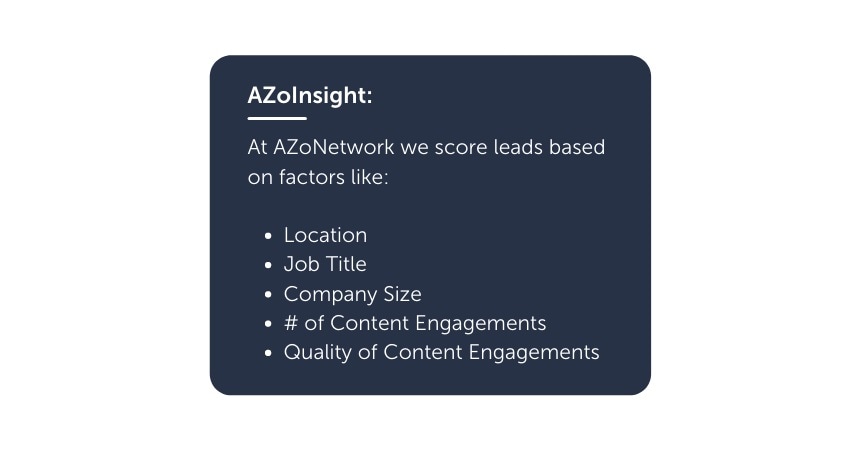
The other side is the intrinsic or the implicit behavioural data.
How many pages have they viewed? Have they been on a solutions pages or is it more sort of top of funnel pages?
We might score solutions pages as 3 points, but the top of funnel pieces as 1 point. Have they watched a webinar or downloaded an eBook? Yeah, that's an extra 10 points. And then is there a specific commercial inquiry that tends to triumph all of that, and we might give them 30 points for showing commercial intent on a particular inquiry.
A fortune 500 director who's been on one page is still pretty important, even though there's not necessarily the behavioural intent there. If you weighed that against a small business manager from a company that has been all over your website, downloaded all the collateral and watched all of the content then that's where it can get a little tricky.

There's no straight answer for this, but at least if you are scoring it and have a process in place to measure prospects, you can prioritize where you spend your time and at least frame and give some context to the people who are following up on these conversations.
Providing fewer, but a higher level of sales qualified lead per sales person per week, means that they're able to put more effort into the leads that you do pass through, as opposed to just being overwhelmed with you passing all of your leads through.
New Marketing Science Podcast Episode: Selling Science
Impact of COVID-19 on Science Marketing
(Danny): It would have been impossible doing this survey without addressing COVID-19 as it was a massively impactful event on every market in the world.
The first question we asked was about the impact, and you can see in this word cloud below some of the recurring themes.
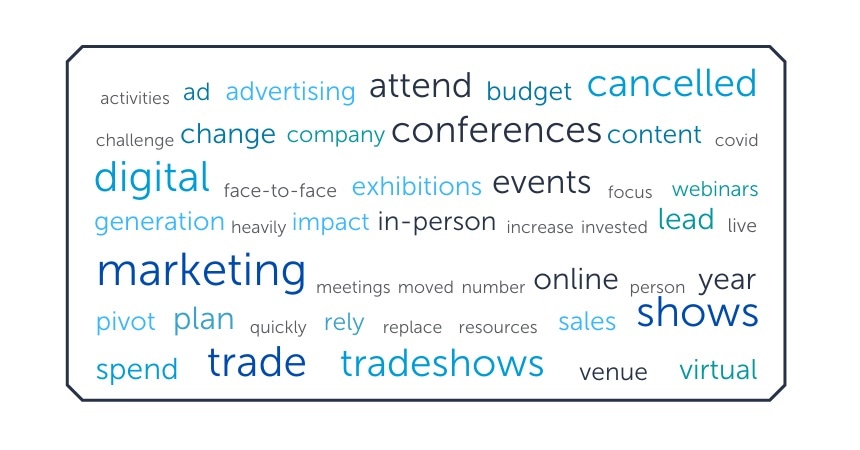
It was no shock to see that 49% of respondents stated, they have been highly impacted and 42% had been impacted in some way.
Interestingly several respondents stated that attending conferences was their sole source of lead generation.
The impact of COVID to some businesses has been absolutely enormous. And how you react to that is obviously going to have a big say in the year you've had.
We believe the 9% of companies that stated they weren't impacted at all, already had remote working and digital marketing deeply rooted in their existing strategies.
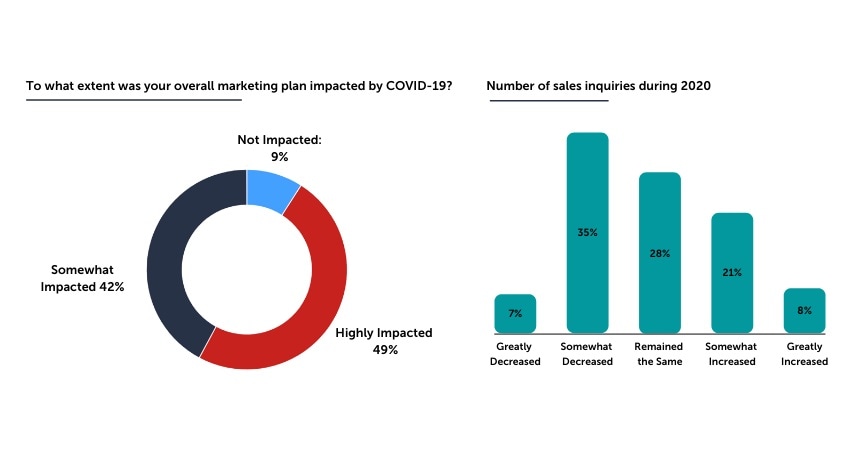
The ability to pivot quickly and the increase in demand for certain products, specifically within healthcare, have resulted in 29% of respondents seeing an increase in sales, which is great.
COVID has sped up the business need to transition to a more mobile and more digital workforce. This was happening already but will now happen a lot faster.
This has obvious challenges for business leaders but also possibilities. Here's a quote from one of the respondents. They said:
We previously relied almost entirely on trade shows and conferences. We've moved to almost entirely digital advertising this year. And whilst when trade shows return, we will resume to some in-person events. We will likely attend far fewer and continue to incorporate more digital advertising.
How will your organization adapt to this change? The mindset of the senior leadership is going to have a huge bearing on your market positions going forward.
2021 Marketing Goals, Priorities and Challenges
Scientific Marketing Goals
(Elizabeth): The chart below shows the percentage of our participants who rated the marketing goals as a very high priority for 2021.
These are the high-level strategic marketing goals that we asked about. I'm not too surprised to see lead generation and generating inbound sales revenue as the top two of the pack here.
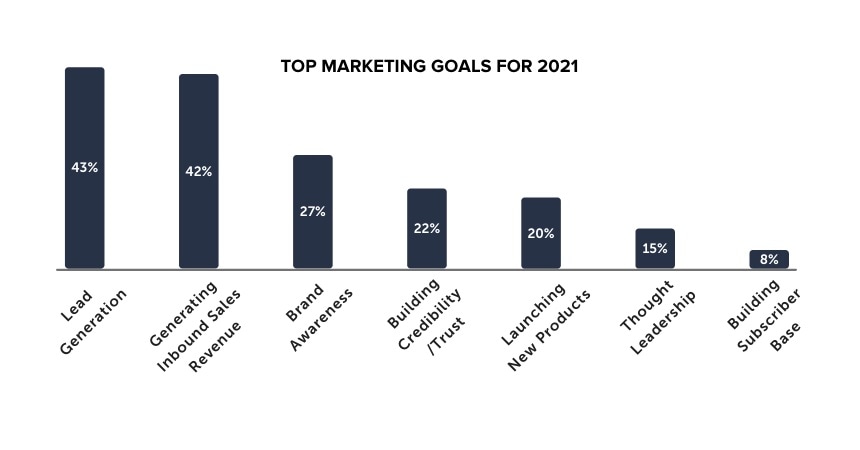
That's probably because those are the metrics that are a little bit easier to measure and to prove. I've worked in organizations or teams before where we've focused on those two because they are the results you show the C-suite to prove your value and marketing initiatives.
It's easier, especially if you've got a CRM tracking those. But I think it's really dangerous to only focus on those two things.
Topics like brand awareness, building credibility and trust, thought leadership, those are all rated quite a bit lower here on the scale of priorities. But are really important. Sometimes you just need to become a little bit more creative in how you might measure those things.
At AZoNetwork, brand awareness is very important and is a big priority for us moving into the future. So we are measuring that in part by looking at direct traffic and branded searches.

These goals are very important for driving more qualified leads into your funnel. Very few people in your sales funnel are actually going to have purchase intent at the moment they become aware of your organisation .
Things like brand awareness and thought leadership are really important for staying top of mind and help you to nurture prospects until they are ready to buy.
Scientific Marketing Priorities for 2021
(Franky): Your scientific marketing priorities reflect who you want to be? Do you want to be the go-to experts in your industry?
It's not just about products. The products will come, but you take care of the brand awareness and the thought leadership and the commercial intent will naturally follow.
It's more effective to move away from the product focused feature bash and focus on educational content and storytelling.
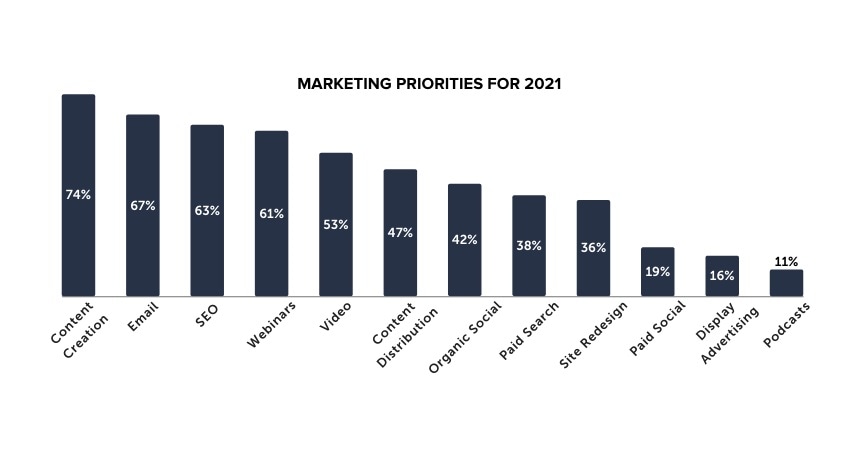
Content creation is the fuel driving marketing campaigns so it's no surprise to see this as the highest priority.
Email never really dies. It's been around for a good 30 odd years and is still a very effective way still of interacting and engaging with your audience. But that's provided that you respect their email address, you respect their data and only contact them as and when you have something relevant to what they've told you they're interested in.

And SEO. More and more people are taking care of their own websites and getting their own house in order.
Podcasts are becoming more frequently used for scientific marketing as it's a great channel for discussing their subject areas. It fits right in with building brand awareness and thought leadership.
Scientific Marketing Challenges for 2021
(Danny): It's hard enough when you're in a member of a larger team, to keep up with all the new marketing tactics so if you're a single person marketing department then it is essentially impossible.
And that's reflected here in the tactics that our respondents are finding the most challenging: webinars and video 44%, SEO 38%.
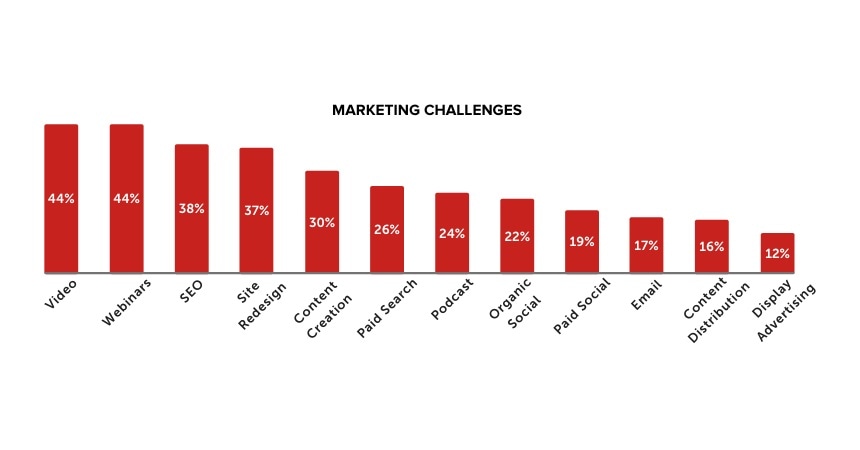
Companies have established that creating high quality, highly engaging digital content like videos and webinars is a real focus for them. This is great because of the benefits we've previously mentioned.
At the same time, businesses also want to make sure that they are ranking higher for their key search terms.
There's no surprise that these three are ranked as important, but also as the most challenging because they can often require a higher level of knowledge, experience and skill that you might not have in-house or within your team.
Some marketing departments will hire in-house videographers to focus solely on creating high quality video content. Between the 3 of us at AZoNetwork, we create video content, but when we're doing client video work, we have a whole team that will do that because to create the really high quality stuff, it takes a lot of expertise and a lot of experience.
And so if you're one of the marketers who's looking at these digital tactics and thinking you haven't got the right skill set, then it's really important to consider how you're going to get the best results.
Be comfortable, knowing what you don't know
We said earlier, it's really difficult for marketers to keep up to date with everything when there's a new tactic that you think is going to work for your business coming up every week.
When it makes strategic and financial sense then outsource where appropriate, because you've only got so much time in the day. If you really want to get that high impact content and you don't have the skills in house, then definitely look to outsource where it makes sense.
Ask about digital marketing
The above edited transcript came from webinar 1 in The Marketing Science Webinar Series. This is now available on demand by clicking the link below:
Watch the Webinar On Demand Now